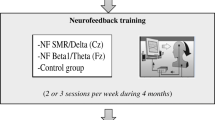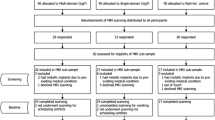Abstract
Neurofeedback training (NFT) has shown to be promising and useful to rehabilitate cognitive functions. Recently, brain–computer interfaces (BCIs) were used to restore brain plasticity by inducing brain activity with an NFT. In our study, we hypothesized that an NFT with a motor imagery-based BCI (MI-BCI) could enhance cognitive functions related to aging effects. To assess the effectiveness of our MI-BCI application, 63 subjects (older than 60 years) were recruited. This novel application was used by 31 subjects (NFT group). Their Luria neuropsychological test scores were compared with the remaining 32 subjects, who did not perform NFT (control group). Electroencephalogram changes measured by relative power (RP) endorsed cognitive potential findings under study: visuospatial, oral language, memory, intellectual and attention functions. Three frequency bands were selected to assess cognitive changes: 12, 18, and 21 Hz (bandwidth 3 Hz). Significant increases (p < 0.01) in the RP of these frequency bands were found. Moreover, results from cognitive tests showed significant improvements (p < 0.01) in four cognitive functions after performing five NFT sessions: visuospatial, oral language, memory, and intellectual. This established evidence in the association between NFT performed by a MI-BCI and enhanced cognitive performance. Therefore, it could be a novel approach to help elderly people.






Similar content being viewed by others
References
Angelakis E, Stathopoulou S, Frymiare JL, Green DL, Lubar JL, Kounios J (2007) EEG neurofeedback: a brief overview and an example of peak alpha frequency training for cognitive enhancement in the elderly. Clin Neuropsychol 21:110–129
Arns M, Heinrich H, Strehl U (2014) Evaluation of neurofeedback in ADHD: the long and winding road. Biol Psychol 95:108–115
Baker SN (2007) Oscillatory interactions between sensorimotor cortex and the periphery. Curr Opin Neurobiol 17(6):649–655
Bastiaansen M, Hagoort P (2006) Oscillatory neuronal dynamics during language comprehension. Prog Brain Res 159:179–196
Bauer RH (1976) Short-term memory: EEG alpha correlates and the effect of increased alpha. Behav Biol 17(4):425–433
Burke SN, Barnes CA (2006) Neural plasticity in the ageing brain. Nat Rev Neurosci 7:30–40
Chartock HE, Glassman PR, Poon LW, Marsh GR (1975) Changes in alpha rhythm asymmetry during learning of verbal and visuospatial tasks. Physiol Behav 15(2):237–239
Christensen AL (1979) A practical application of the Luria methodology. J Clin Exp Neuropsychol 1(3):241–247
Clark L, Blackwell AD, Aron AR, Turner DC, Dowson J, Robbins TW, Sahakian BJ (2007) Association between response inhibition and working memory in adult ADHD: a link to right frontal cortex pathology? Biol Psychiatry 61(12):1395–1401
Coben R, Linden M, Myers TE (2010) Neurofeedback for autistic spectrum disorder: a review of the literature. Appl Psychophysiol Biofeedback 35:83–105
Craik FIM, Salthouse TA (2011) Handbook of aging and cognition II. Psychology Press, Hove
Curtis CE, D’Esposito M (2003) Persistent activity in the prefrontal cortex during working memory. Trends Cogn Sci 7(9):415–423
Daly JJ, Wolpaw JR (2008) Brain–computer interfaces in neurological rehabilitation. Lancet Neurol 7(11):1032–1043
Doppelmayr M, Klimesch W, Stadler W, Pöllhuber D, Heine C (2002) EEG alpha power and intelligence. Intelligence 30(3):289–302
Egner T, Gruzelier JH (2001) Learned selfregulation of EEG frequency components affects attention and event-related brain potentials in humans. Neuroreport 12(18):4155–4159
Egner T, Zech TF, Gruzelier JH (2004) The effects of neurofeedback training on the spectral topography of the electroencephalogram. Clin Neurophysiol 115(11):2452–2460
Gevensleben H, Holl B, Albrecht B, Vogel C, Schlamp D, Kratz O, Studer P, Rothenberger A, Moll GH, Heinrich H (2009) Is neurofeedback an efficacious treatment for ADHD? A randomised controlled clinical trial. J Child Psychol Psychiatry 50(7):780–789
Ghaziri J, Tucholka A, Larue V, Blanchette-Sylvestre M, Reyburn G, Gilbert G, Lévesque J, Beauregard M (2013) Neurofeedback training induces changes in white and gray matter. Clin EEG Neurosci 44(4):265–272
Grady CL, Craik FI (2000) Changes in memory processing with age. Curr Opin Neurobiol 10(2):224–231
Guger C, Daban S, Sellers E, Holzner C, Krausz G, Carabalona R, Gramatica F, Edlinger G (2009) How many people are able to control a P300-based brain–computer interface (BCI)? Neurosci Lett 462:94–98
Güntekin B, Basar E (2007) Emotional face expressions are differentiated with brain oscillations. Int J Psychophysiol 64:91–100
Hadjidimitriou S, Zacharakis A, Doulgeris P, Panoulas K, Hadjileontiadis L, Panas S (2010) Sensorimotor cortical response during motion reflecting audiovisual stimulation: evidence from fractal EEG analysis. Med Biol Eng Comput 48(6):561–572
Hanslmayr S, Staudigl T, Fellner MC (2012) Oscillatory power decreases and long-term memory: the information via desynchronization hypothesis. Front Hum Neurosci 6:74
Hyvärinen A, Oja E (2000) Independent component analysis: algorithms and applications. Neural Netw 13(4):411–430
Jasper HH (1958) Report of committee on methods of clinical examination in electroencephalography. Electroenceph Clin Neurophysiol 10:370–375
Kim JS, Chung CK (2008) Language lateralization using MEG beta frequency desynchronization during auditory oddball stimulation with one-syllable words. Neuroimage 42(4):1499–1507
Klimesch W (1999) EEG alpha and theta oscillations reflect cognitive and memory performance: a review and analysis. Brain Res Rev 29(2):169–195
Lubar JO, Lubar JF (1984) Electroencephalographic biofeedback of SMR and beta for treatment of attention deficit disorders in a clinical setting. Biofeedback Self Regul 9(1):1–23
Lubar JF, Swartwood MO, Swartwood JN, O’Donnell PH (1995) Evaluation of the effectiveness of EEG neurofeedback training for ADHD in a clinical setting as measured by changes in TOVA scores, behavioral ratings, and WISC-R performance. Biofeedback Self Regul 20(1):83–99
McCreadie KA, Coyle DH, Prasad G (2013) Sensorimotor learning with stereo auditory feedback for a brain–computer interface. Med Biol Eng Comput 51(3):285–293
Neuper C, Scherer R, Wriessnegger S, Pfurtscheller G (2009) Motor imagery and action observation: modulation of sensorimotor brain rhythms during mental control of a brain–computer interface. Clin Neurophysiol 120(2):239–247
Pfurtscheller G, Neuper C (1997) Motor imagery activates primary sensorimotor area in humans. Neurosci Lett 239(2):65–68
Pineda JA, Silverman DS, Vankov A, Hestenes J (2003) Learning to control brain rhythms: making a brain–computer interface possible. IEEE Trans Neural Syst Rehabil Eng 11(2):181–184
Ros T, Munneke MA, Ruge D, Gruzelier JH, Rothwell JC (2010) Endogenous control of waking brain rhythms induces neuroplasticity in humans. Eur J Neurosci 31(4):770–778
Schalk G, McFarland DJ, Hinterberger T, Birbaumer N, Wolpaw JR (2004) BCI2000: a general-purpose brain–computer interface (BCI) system. IEEE Trans Biomed Eng 51:1034–1043
Staufenbiel SM, Brouwer AM, Keizer AW, VanWouwe NC (2014) Effect of beta and gamma neurofeedback on memory and intelligence in the elderly. Biol Psychol 95:74–85
Tan G, Thornby J, Hammond DC, Strehl U, Canady B, Arnemann K, Kaiser DA (2009) Meta-analysis of EEG biofeedback in treating epilepsy. Clin EEG Neurosci 40(3):173–179
Thornton KE, Carmody DP (2008) Efficacy of traumatic brain injury rehabilitation: interventions of qEEG-guided biofeedback, computers, strategies, and medications. Appl Psychophysiol Biofeedback 33(2):101–124
United Nations (2013) Department of Economic and Social Affairs, Population Division 2013, World Population Ageing ST/ESA/SER.A/348. Available via DIALOG. http://www.un.org/en/development/desa/population/publications/pdf/ageing/WorldPopulationAgeing2013.pdf. Accessed 26 Jan 2015
Vernon DJ (2005) Can neurofeedback training enhance performance? An evaluation of the evidence with implications for future research. Appl Psychophysiol Biofeedback 30(4):347–364
Vernon D, Egner T, Cooper N, Compton T, Neilands C, Sheri A, Gruzelier J (2003) The effect of training distinct neurofeedback protocols on aspects of cognitive performance. Int J Psychophysiol 47:75–85
Wang JR, Hsieh S (2013) Neurofeedback training improves attention and working memory performance. Clin Neurophysiol 124(12):2406–2420
Weiss S, Mueller HM (2012) Too many betas do not spoil the broth”: the role of beta brain oscillations in language processing. Front Psychol 3:201
Welch PD (1967) The use of fast Fourier transform for the estimation of power spectra: a method based on time averaging over short, modified periodograms. IEEE Trans Audio Electroacoust 15(2):70–73
Wolpaw JR, Birbaumer N, Heetderks WJ, McFarland DJ, Peckham PH, Schalk G, Donchin E, Quatrano LA, Robinson CJ, Vaughan TM (2000) Brain-computer interface technology: a review of the first international meeting. IEEE Trans Rehabil Eng 8(2):164–173
Wolpaw JR, Birbaumer N, McFarland DJ, Pfurtscheller G, Vaughan TM (2002) Brain–computer interfaces for communication and control. Clin Neurophysiol 113(6):767–791
Young KD, Zotev V, Phillips R, Misaki M, Yuan H, Drevets WC, Bodurka J (2014) Real-time FMRI neurofeedback training of amygdala activity in patients with major depressive disorder. PLoS One 9(2):e88785. doi:10.1371/journal.pone.0088785
Zoefel B, Huster RJ, Herrmann CS (2011) Neurofeedback training of the upper alpha frequency band in EEG improves cognitive performance. Neuroimage 54(2):1427–1431
Acknowledgments
This research was supported in part by the Projects TEC2014-53196-R of ‘Ministerio de Economía y Competitividad’ and FEDER, the ‘Proyecto Cero’ 2011 on Ageing from Fundación General CSIC, Obra Social La Caixa and CSIC, and the Project VA059U13 of “Consejería de Educación”. Finally, J. Gomez-Pilar was in receipt of a PIF-UVA Grant from University of Valladolid.
Author information
Authors and Affiliations
Corresponding author
Rights and permissions
About this article
Cite this article
Gomez-Pilar, J., Corralejo, R., Nicolas-Alonso, L.F. et al. Neurofeedback training with a motor imagery-based BCI: neurocognitive improvements and EEG changes in the elderly. Med Biol Eng Comput 54, 1655–1666 (2016). https://doi.org/10.1007/s11517-016-1454-4
Received:
Accepted:
Published:
Issue Date:
DOI: https://doi.org/10.1007/s11517-016-1454-4




